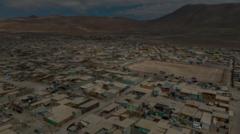Fog harvesting involves the use of fine mesh structures that capture moisture from clouds, which condense into water droplets that are then collected in storage tanks. While this technology has been in use at a small scale in various parts of South and Central America, Dr. Gamberini emphasizes the potential for larger-scale applications in urban areas. Her research teams have utilized satellite imagery and weather forecasts to assess the volume of water that can be harvested from the fog that regularly blankets Alto Hospicio, produced by warm, moist air over the cold ocean.
The results of their study indicate that by employing just 17,000 square meters of mesh, it would be possible to meet the weekly water demand of 300,000 liters currently supplied by trucks to the city's impoverished slums. Additionally, a smaller area of 110 square meters could be sufficient for irrigating local green spaces, and the collected fog water can also support hydroponic agriculture, yielding substantial amounts of green vegetables.
In a region where traditional water sources like underground aquifers are diminishing due to increasing urban populations and industrial water demands, fog harvesting presents an urgent opportunity to secure fresh water and bolster the resilience of communities against climate change. The team is in the process of creating a comprehensive fog harvesting map of Chile to optimize water capture opportunities across the country. As Dr. Carter states, "water from the clouds" not only stands to improve access to clean water but also enhances city resilience to the ongoing climate crisis.
The results of their study indicate that by employing just 17,000 square meters of mesh, it would be possible to meet the weekly water demand of 300,000 liters currently supplied by trucks to the city's impoverished slums. Additionally, a smaller area of 110 square meters could be sufficient for irrigating local green spaces, and the collected fog water can also support hydroponic agriculture, yielding substantial amounts of green vegetables.
In a region where traditional water sources like underground aquifers are diminishing due to increasing urban populations and industrial water demands, fog harvesting presents an urgent opportunity to secure fresh water and bolster the resilience of communities against climate change. The team is in the process of creating a comprehensive fog harvesting map of Chile to optimize water capture opportunities across the country. As Dr. Carter states, "water from the clouds" not only stands to improve access to clean water but also enhances city resilience to the ongoing climate crisis.

















